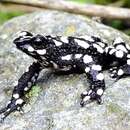en
names in breadcrumbs


The starry night toad (Atelopus arsyecue) is a species of toad in the family Bufonidae endemic to the Sierra Nevada de Santa Marta, Colombia.[2] Its natural habitats are sub-Andean and Andean forests, sub-páramo and páramo at 2,000–3,500 m (6,600–11,500 ft) above sea level. Reproduction takes place in fast-flowing rivers. It is named after its unique coloration, being largely black with white spots.[3]
It is threatened by chytridiomycosis and habitat loss and was feared extinct for over 30 years.[1] However, its continued existence was known to the Arhuaco community in Sogrome, who referred to the animal as gouna and considered its habitat a sacred location. In 2019, the tribe consented to collaboration with researchers and showed them the living population, marking the first sighting of this species by researchers in over 30 years.[3]
The starry night toad (Atelopus arsyecue) is a species of toad in the family Bufonidae endemic to the Sierra Nevada de Santa Marta, Colombia. Its natural habitats are sub-Andean and Andean forests, sub-páramo and páramo at 2,000–3,500 m (6,600–11,500 ft) above sea level. Reproduction takes place in fast-flowing rivers. It is named after its unique coloration, being largely black with white spots.
It is threatened by chytridiomycosis and habitat loss and was feared extinct for over 30 years. However, its continued existence was known to the Arhuaco community in Sogrome, who referred to the animal as gouna and considered its habitat a sacred location. In 2019, the tribe consented to collaboration with researchers and showed them the living population, marking the first sighting of this species by researchers in over 30 years.